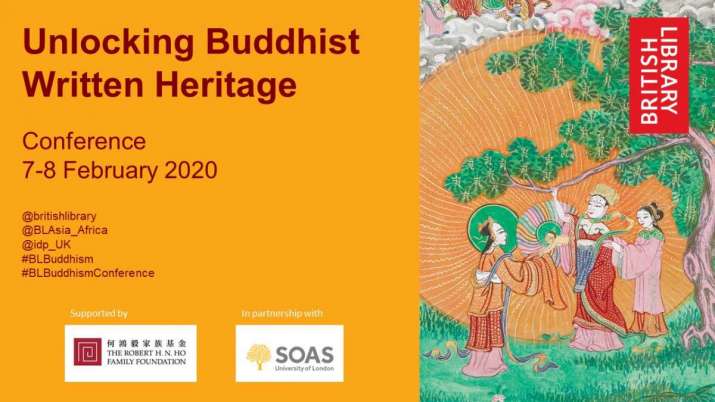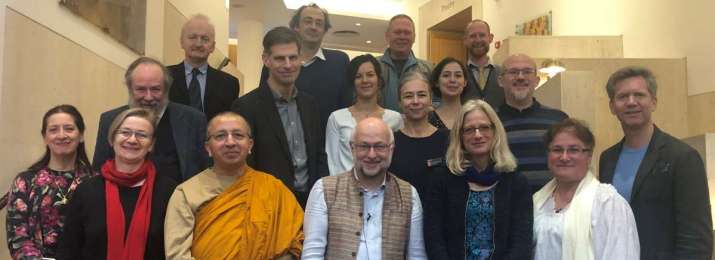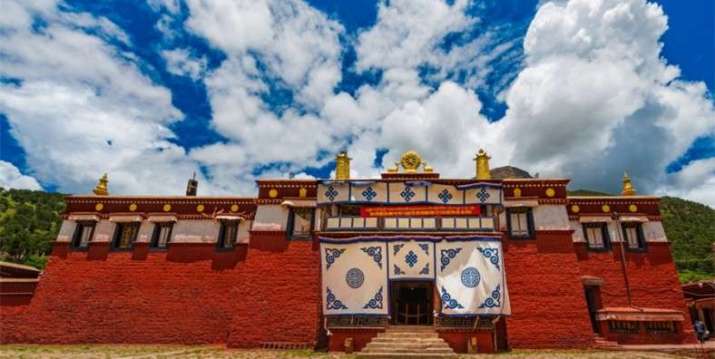FEATURES|THEMES|Exhibitions and Conferences
New Channels of Discovery and Discussion: The British Library’s Unlocking Buddhist Written Heritage Lectures
 From bl.uk
From bl.ukMany ancient Buddhist manuscripts, which had been brought from India by medieval Indian and Tibetan monks, are still preserved in Tibet, especially at the old monasteries of Sam-yas, Sakya, Nar-thang and Phun-tsho-ling. These manuscripts, however, being worshipped as precious relics, and written in a character more or less unknown to the Lamas, are kept sealed up and rarely seen by the Lamas themselves. — Laurence Austine Waddell (1854–1938), The Buddhism of Tibet, or Lamaism (1895)
The British Library held a conference titled “Unlocking Buddhist Written Heritage” from 7–8 February this year, bringing together scholars from around the world to examine Buddhist texts and manuscripts through the lens of collections. The conference was held in in partnership with The School of Oriental and African Studies and supported by the Robert H. N. Ho Family Foundation. The British Library team, led by head of Asia and Africa collections Dr. Luisa Elena Mengoni, with Matt Kimberley and Charles Manson, are now releasing a series of recordings of the speakers’ presentations, with full audio and slide visuals available on the British Library YouTube playlist.
The first recording to be made available is keynote speaker Dr. Birgit Kellner’s rigorous and thought-provoking lecture “Worshipped as Precious Relics? On the Valuation of Indian Manuscripts in the History of Tibetan Buddhism.” More lectures will be added soon, with several of their speakers previously interviewed by Buddhistdoor Global.
Dr. Kellner’s lecture focused on a large body of Indian Buddhist literature that “were or might have been found” in Tibet. These texts, although rooted doctrinally in the Indic world of Buddhism, have been used in Tibetan Buddhism by Tibetan actors as cultural objects of prestige, legitimation, and spiritual authority. This phenomenon in Tibetan Buddhist history bears superficial similarities to how Japan and Korea absorbed Chinese as the canonical language by which Buddhist teachings were disseminated in diverse periods, and how in turn China’s sangha and imperial authorities obsessed over obtaining the “Indian originals” of Chinese translations of Buddhist texts.
As Dr. Kellner noted to Dr. Serena Biondo, who represented Buddhistdoor Global at the conference, the category of “Indo-Tibetan Buddhism” (which I distinctly remember using as a student of Buddhist studies), “is actually an ideology that has been perpetuated by certain traditions within Tibet, that is to say: certain Tibetan Buddhist traditions would like to see themselves—and have also historically presented themselves—as the repository of ‘authentic Indian Buddhism,’ especially in interactions with the Chinese. . . . At the same time, some people have started to look more specifically at how India, as a cultural marker, and Indian tradition come up in individual and distinct historical contexts such as art history, for instance, or doctrinal polemics, thus offering different sides of inquiry.”
Examining the dimensions of this complex debate requires a more sophisticated look at the whole idea of “collections,” which is what the British Library does best. Dr. Kellner did precisely this in her research context. Kellner sets the scene by highlighting the interaction of Tibetans with the Indian cultural sphere as being driven by local rulers engaging with this Indic spiritual tradition, which had arrived variously from Kashmir, Nalanda, Vikramashila, and the Kathmandu Valley. The thematic diversity of these texts is well known, but the ways in which they were moved back and forth down the centuries and between religious centers formed dynamic networks during the Second Diffusion (between the 11th and 14th centuries) are less often discussed.
 Speakers from the “Unlocking Buddhist Written Heritage” conference, 7-8 February 2020. From bl.uk
Speakers from the “Unlocking Buddhist Written Heritage” conference, 7-8 February 2020. From bl.ukDr. Kellner points out that Sanskrit never became a liturgical language in Tibet. Tibetans relied on their own language for composing and interpreting Buddhist texts, especially once Buddhism disappeared as an independent cultural force in India. After the 14th century, Indian texts were rarely used for their content but have survived until today, with a total of 60,000 extant manuscripts (3,500–4,000 texts and fragments) scattered through the Tibetan Autonomous Region alone. Dr. Kellner focuses on a surviving collection taken from Reting Monastery, which was founded in 1056 (but no longer stands today), and is now stored at the Potala Palace.
In considering such catalogues or collections, different genres must be accounted for on their own terms, and diverse historical players and periods must be considered (in Dr. Kellner’s case, the Second Diffusion and the late 19th to early 20th centuries). Valuation and meaning take on different shades in different contexts. How are they categorized? The broadest level of Tibetan taxonomy is “bodily supports,” “verbal supports,” and “mental supports,” and within the verbal are the categories of Tibetan books and Indian books. The Reting Collection is included in this category, with a total of 29 titles split between a final division: 17 to Atisha (982–1054) and 12 to “the translator.”
As indicated in this taxonomy, the prestige of texts depends on their association (the closer and more direct, the better) to specific figures in the Kadampa tradition. More broadly, Indian manuscripts retain a presence in cultural and social memory through the individuals that produced or brought them to Tibet. Dr. Kellner explains this through charting Atisha’s journey from Vikramashila via Kathmandu to western and central Tibet. A collection is inevitably part of a master’s teaching material, and passed on to his or her disciples, who then would likely try to disseminate them or ensure their safety by imparting them to an institution such as a monastery. However, there is never simply a linear process of transmission to archiving. There would have likely been disputes or legal problems arising from the idea of monastic manuscript inheritance. Issues of master-disciple succession, Vinaya, and regional politics no doubt shaped how a collection would look in the 20th or 21st centuries.
Between the late 19th century and early 20th century, a disparate succession of Bengali, European, and Japanese travelers with diverse backgrounds and agendas saw for themselves, through divergent experiences and obstacles, that accessing Indian manuscripts in the libraries and archives of Tibetan monasteries was a highly regulated affair requiring special permission from senior figures in the monastic administrations. Despite these special arrangements, palm-leaf Sanskrit manuscripts were still kept together with bound Tibetan books in dark and dusty rooms, indicating their inseparability from the sacred geography of a monastery. However, this idea of “closeness” to historical figures cut both ways: during his journeys to Tibet in 1934, 1936, and 1938, the “father of the Indian travelogue,” Rahul Sankrityayan (1893–1963), noticed how an important Buddhist figure’s clothes, personal trinkets, or religious paraphernalia such as begging bowls always outranked the Indian Sanskrit texts associated with them. The recitation and reading of the contents were not always the highest priority, with a nexus of other pious concerns often leading to the manuscripts being sealed up or repurposed for rituals and other devotional needs, such as scripture deposition in stupas or consecrating enclosure in relics or statues.
 The rebuilt Reting Monastery in Lhunzhub County, Lhasa. From tibettours.com
The rebuilt Reting Monastery in Lhunzhub County, Lhasa. From tibettours.comDr. Kellner’s speech offered a fascinating glimpse into the world of collections in a unique historical context. Unlike a process of deciding canonicity at some kind of council, manuscripts were produced locally, picked up, reproduced, and organically distributed at many different junctures, many of them lost historical records. A “collection,” therefore, is not like the careful and rigorous cataloguing of modern libraries. In the Second Diffusion, the word would have been understood as a body embedded in a network of masters’ texts on the move in different local environments. Here, collections are bodies of religious knowledge being circulated, moving back and forth, splitting and reforming, and represented in different ways. In the modern era, “collections” indicates something more static, placed under seal and no longer physically a part of knowledge circulation. They are jealously guarded, seen as emblematic of the Dharma, but no longer decipherable to their own wardens, with many of the manuscripts left to the practitioners of an emergent discipline called Buddhist studies to pore over, translate, and reshare with the world.
See more
Indian manuscripts in the history of Tibetan Buddhism (YouTube)
The British Library (YouTube)
Related features from Buddhistdoor Global
An Interview with Birgit Kellner on the Role of Indian Manuscripts in the History of Tibetan Buddhism
Prof. T. H. Barrett and the State of Contemporary Buddhist Studies
Of Scriptures and Enchantment: An Interview with Sam van Schaik on a Grimoire of Magic Spells from Dunhuang
Related news from Buddhistdoor Global
Buddhist Written Heritage to be Discussed at British Library Conference
British Library Exhibition Explores the Roots and Relevance of Buddhism
Related blog posts from Buddhistdoor Tea House
“Unlocking Buddhist Written Heritage” at the British Library














